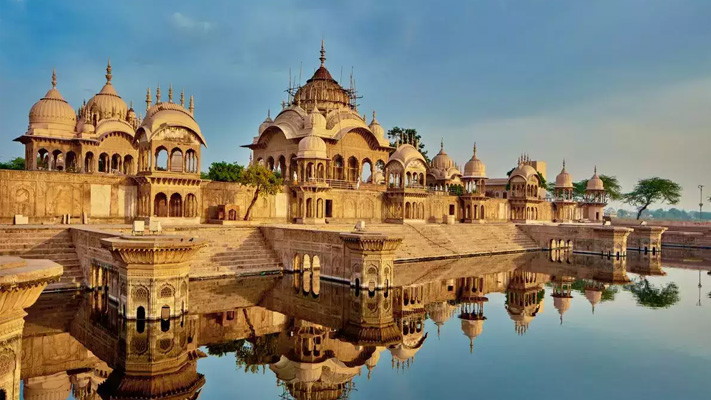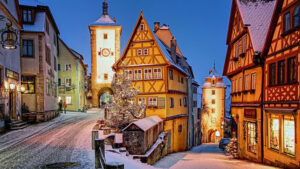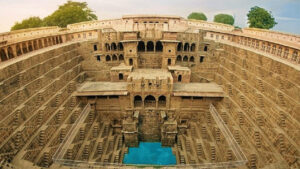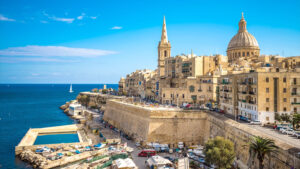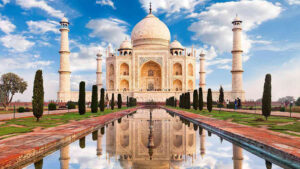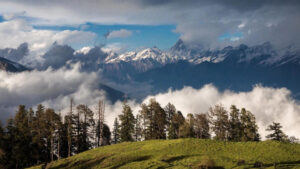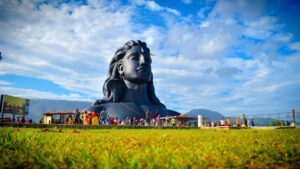10 ANCIENT CITIES IN INDIA – JOURNEY THROUGH TIME AND UNCOVER THE GLORIOUS PAST

India is a land steeped in history and brimming with ancient cities that tell stories of civilizations long gone. From the sacred city of Varanasi, believed to be one of the oldest inhabited cities in the world, to the majestic ruins of Hampi and the intricately carved temples of Madurai, these ancient cities are windows into India’s glorious past. Each city carries its own unique charm and architectural marvels, showcasing the achievements of ancient civilizations and offering a glimpse into the rich cultural heritage of the country. As you explore these ancient cities, you’ll be transported back in time, surrounded by the echoes of bygone eras and the remnants of once-thriving civilizations. Prepare to embark on a journey of discovery and immerse yourself in the captivating history and enchanting allure of India’s ancient cities.

1. Vrindavan
Mathura, situated in the Mathura District of Uttar Pradesh, holds immense religious significance as the holy city where Lord Krishna spent his formative years. Nestled along the banks of the revered River Yamuna, this city effortlessly blends a rich history with a vibrant cultural tapestry. Just a stone’s throw away lies Vrindavan, a town adorned with countless temples dedicated to Lord Krishna and Radha, with the renowned Banke Bihari Temple standing as the most popular among them, attracting devotees from far and wide.
The best time to visit Mathura is during the months of November to March when the weather is pleasant and conducive for exploration.
During your visit, there are several noteworthy activities to partake in:
- Immerse yourself in the grandeur of the Banke Bihari Temple, where you can witness the fervent devotion and experience the spiritual aura.
- Admire the distinctive architecture of the Ranganathaji Temple, a magnificent structure dedicated to Lord Krishna that showcases intricate craftsmanship.
- Embrace the religious ambiance at Keshi Ghat, a revered bathing ghat along the banks of the Yamuna River where you can participate in rituals and witness the sacred rituals taking place.
- Pay a visit to the Hare Rama Hare Krishna Temple, an important religious site for followers of the Hare Krishna movement.
2. Ayodhya
Ayodhya, the birthplace of Lord Rama, is an ancient city with origins dating back to the 6th century BCE. Situated on the banks of the sacred River Sarayu, it holds immense religious significance for followers of Hinduism and Jainism. Ayodhya stands as a spiritual centre, adorned with numerous temples and serene riverside ghats. As you step into the city, you will be greeted by the sight of devotees immersed in prayer, the enchanting sound of melodious chants, and the fragrant aroma of incense permeating the air. Ayodhya truly emanates a spiritual ambiance that captivates the senses.
The best time to visit Ayodhya is from October to December when the weather is pleasant and conducive for exploration.
During your visit, there are several notable activities to engage in:
- Visit the 70 steep steps of Hanuman Garhi, a revered temple dedicated to Lord Hanuman. Climbing these steps is believed to bring blessings and spiritual fulfilment.
- Witness the grandeur of Treta Ke Thakur, a temple complex dedicated to Lord Rama, Sita, and Lakshmana, where you can immerse yourself in the divine atmosphere.
- Soak in the charm of Moti Mahal, an architectural marvel adorned with intricate designs and motifs that reflect the city’s cultural heritage.
- Explore the revered Guptar Ghat, a riverside platform where devotees gather to perform rituals and seek blessings.
- Consider embarking on a day trip to Bahu Begum ka Makabara, a historic mausoleum known for its intricate architecture and serene surroundings.

3. Varanasi
Varanasi, one of the most ancient inhabited cities globally, holds a storied history dating back to 800 BCE. Revered as the abode of Lord Shiva, it stands as a profoundly sacred Hindu pilgrimage destination. Varanasi not only captivates devotees from across India but also allures travellers from around the world. The rituals performed along the revered Ganga Ghats are among the highlights of this spiritual city. Witnessing the mesmerizing Ganga Arti, participating in religious bathing in the holy river, observing Yagya ceremonies, and more, offer profound experiences in Varanasi.
The best time to visit Varanasi is from October to March, when the weather is pleasant and suitable for exploration.
During your visit, there are several remarkable activities to engage in:
- Experience the grandeur of the Ganga Arti, a sacred ritual performed on the banks of the holy Ganges River, where priests offer prayers with incense, lamps, and chants, creating an ethereal ambiance.
- Seek divine blessings in the ancient temples that dot the city, such as the renowned Kashi Vishwanath Temple and the Sankat Mochan Hanuman Temple, immersing yourself in their spiritual energy.
- Explore Sarnath, a revered Buddhist pilgrimage site near Varanasi, where Lord Buddha delivered his first sermon. Discover ancient ruins, monasteries, and the iconic Dhamek Stupa that symbolizes the birth of Buddhism.
- Embark on a morning boat ride along the Ganges River, witnessing the spiritual fervor of devotees, the timeless beauty of the ghats, and the rising sun casting a golden glow on the waters.
- Indulge in the delectable treats of Varanasi, such as the famous Banarasi Paan (betel leaf), traditional sweets like Malaiyo and Kachori, and the city’s distinct cuisine.
4. Dwarka
Dwarka, an ancient city situated in the state of Gujarat, holds significant spiritual importance. The name “Dwarka” translates to “the door to moksha” (liberation), reflecting the town’s deep-rooted spiritual aura. It is regarded as one of the revered destinations of the Char Dham Yatra pilgrimage. This region is adorned with magnificent temples and religious monuments, preserving India’s rich cultural heritage. Every year, thousands of pilgrims flock to Dwarka to seek divine blessings. Among the notable attractions is the Nageshwara Temple, one of the twelve Jyotirlingas (holy shrines dedicated to Lord Shiva).
Beyond its sacred significance, Dwarka also boasts tranquil beaches that captivate nature lovers from various parts of India.
The best time to visit Dwarka is from November to February when the weather is pleasant, offering a comfortable travel experience.
During your visit, there are several enticing activities to enjoy:
- Immerse yourself in the spiritual ambiance at the Rukmini Temple, dedicated to Goddess Rukmini, the consort of Lord Krishna, and experience the divine connection.
- Embark on a camel ride along the picturesque coastal stretches, enjoying the scenic beauty and the rhythmic sway of the camels.
- Visit the Bhadkeshwar Mahadev Temple, an ancient temple located on an island accessible by a narrow strip of land, offering a serene atmosphere for contemplation and worship.
- Explore Sharda Peeth, a revered seat of learning and one of the 51 Shakti Peethas (sacred sites associated with the Goddess Shakti) in Hindu mythology.
- Indulge in shopping for souvenirs at the local market, where you can find traditional handicrafts, textiles, and other mementos that capture the essence of Dwarka.
5. Puri
Puri, a city situated alongside the Bay of Bengal, is renowned for its revered Jagannatha Temple. As a significant Hindu pilgrimage site, millions of devotees flock to this temple each year. Notably, the Jagannatha Temple houses the largest kitchen on Earth, a sight that must be witnessed to be fully grasped. This ancient city also offers the tranquil beauty of its sea beach and the enchanting Casuarina forests. Just near Puri, the awe-inspiring Konark Sun Temple stands as a major attraction, showcasing majestic architectural opulence.
The best time to visit Puri is from October to March when the weather is pleasant, allowing for a comfortable exploration of the city.
During your visit, there are several engaging activities to enjoy:
- Embrace spirituality at the revered Jagannatha Temple, where you can partake in rituals, witness the elaborate daily ceremonies, and experience the deep spiritual connection with Lord Jagannatha.
- Admire the architectural brilliance of the Konark Sun Temple, a UNESCO World Heritage Site renowned for its intricate stone carvings and stunning craftsmanship that depict mythological stories.
- Feel refreshed and rejuvenated at Puri Beach, where you can unwind amidst the soothing sounds of the waves, take leisurely walks along the shoreline, or simply relax while enjoying the serene coastal atmosphere.
- Explore the Sudarshan Craft Museum, which showcases a wide array of intricate and exquisite handicrafts from the region, providing insights into the rich artistic heritage of Puri and Odisha.

6. Madurai
Madurai, often referred to as the cultural capital of Tamil Nadu, is a captivating ancient city situated on the banks of the River Vaigai. One of the major highlights of Madurai is the magnificent Meenakshi Amman Temple, an architectural marvel with a history dating back to the 17th century. This temple’s grandeur and intricate design make it a sight to behold. With its rich cultural heritage and historical significance, Madurai earned the title of ‘Cultural Capital’. The city’s trade relations with Rome in ancient times further contribute to its cultural vibrancy. Madurai’s allure extends to its numerous historical structures that entice heritage enthusiasts from around the world.
The best time to visit Madurai is from October to March when the weather is pleasant, allowing for comfortable exploration of the city.
During your visit, there are several captivating activities to enjoy:
- Admire the mesmerizing beauty of the Meenakshi Amman Temple, where you can witness the intricate sculptures, vibrant paintings, and the grand architecture that reflect the city’s rich cultural heritage.
- Gain insights into the life and legacy of Mahatma Gandhi at the Gandhi Museum, which houses an extensive collection of artefacts and exhibits related to the father of the nation.
- Witness the serene beauty of the Thiruparankundram Murugan Temple, an ancient hill temple dedicated to Lord Murugan, adorned with intricate carvings and offering breathtaking views from its elevated location.
- Embark on a sightseeing tour to the Samanar Hills, known for their Jain cave temples and ancient inscriptions that provide glimpses into the region’s historical past.
- Indulge in the flavours of Madurai by sampling the local delicacies, such as the famous Madurai Jigarthanda (a sweet milk-based beverage), various dosa varieties, and delectable street food.
7. Ujjain
Ujjain, considered one of the most sacred cities in India and a revered Hindu pilgrimage destination, boasts a history dating back to 700 BCE. This ancient city is hailed as the humble abode of Lord Shiva and is home to one of the twelve Jyotirlingas, making it an important spiritual centre. Often referred to as the ‘Temple City,’ Ujjain is adorned with a myriad of temples, both ancient and contemporary. Resting on the banks of the holy River Shipra, it holds great significance as the host city for the legendary Kumbh Mela. With its deep-rooted spiritual heritage, Ujjain emanates an enchanting aura that stirs the imagination.
The best time to visit Ujjain is from October to March when the weather is pleasant and suitable for exploration.
During your visit, there are several captivating activities to engage in:
- Seek the blessings of Lord Shiva at the Mahakaleshwar Temple, a renowned shrine where the divine presence is deeply felt, and rituals are performed with great reverence.
- Take a sacred bath in the holy River Shipra, believed to cleanse the soul and bestow spiritual purification, creating a profound connection with the divine.
- Witness the Shipra Aarti, a divine ritual where lamps are lit and prayers are offered to the river, creating a mesmerising spectacle of light and devotion.
- Immerse yourself in the spirituality of Gomti Kund, a sacred water tank known for its mythical origins and revered as a site of purification and spiritual rejuvenation.
- If the timing aligns, experience the grandeur of the Kumbh Mela, a massive gathering of devotees from across the country held once every twelve years, offering a unique cultural and spiritual experience.
8. Kannauj
Kannauj, situated in Uttar Pradesh, is a city steeped in a rich legacy that traces back to the times of the Mahabharata and Ramayana. Known for its seamless blend of ancient and modern, Kannauj captivates visitors with its fascinating archaeological sites that stand as testaments to its glorious past. The city has witnessed the reign of various dynasties, contributing to its remarkable heritage and vibrant culture. As you stroll through the narrow streets of Kannauj, the air is filled with the lingering fragrance of perfumes, adding an undeniable charm to the atmosphere.
The best time to visit Kannauj is from October to March, when the weather is pleasant and conducive to exploration.
During your visit, there are several captivating activities to partake in:
- Explore the serene beauty of Lake Bahosi Bird Sanctuary, a haven for avian species and nature enthusiasts alike, offering opportunities for birdwatching and tranquil moments in nature.
- Pay a visit to the Gauri Shankar Temple, a revered Hindu temple dedicated to Lord Shiva and Goddess Parvati, known for its intricate architecture and spiritual ambiance.
- Immerse yourself in the rich history of Kannauj by visiting the Archaeological Museum, where a vast collection of artefacts and relics shed light on the city’s ancient past and cultural heritage.
- Seek spiritual solace at the Annapurna Temple, a sacred shrine dedicated to Goddess Annapurna, the provider of nourishment, and experience a sense of divine presence.
- Embark on an exploration of Suraj Kund, a historic reservoir believed to have been built by King Harsha, offering a serene and picturesque setting for contemplation and relaxation.
9. Patna
Patna, the capital city of Bihar, holds the distinction of being one of the oldest continuously inhabited cities in the world. Previously known as Pataliputra, it served as a prominent centre during the reign of the Mauryan dynasty. Patna bears historical significance in relation to two ancient religions, Buddhism and Jainism. Nestled on the banks of the sacred Ganges River, it stands as the second-largest city in Bihar. Surrounding Patna, there are numerous tourist and religious attractions that attract visitors from various parts of the country.
The best time to visit Patna is from October to March when the weather is pleasant and ideal for exploration.
During your visit, there are several intriguing activities to engage in:
- Immerse yourself in the architectural beauty of Golghar, an iconic monument built in the 18th century, offering panoramic views of the city and the Ganges River.
- Get a taste of religious culture at Mahavir Mandir, a significant temple dedicated to Lord Hanuman, where devotees gather to offer prayers and seek blessings.
- Dive into history at the Jalan Museum, which houses a remarkable collection of artefacts and relics, showcasing the rich cultural heritage and historical importance of the region.
- Visit the ancient university of Nalanda, located near Patna, which was once a renowned centre of learning and attracts visitors with its impressive archaeological remains.
- Witness countless historical artefacts at the Patna Museum, also known as the Jadu Ghar, where you can explore a diverse range of exhibits, including sculptures, paintings, and relics that span various periods of history.

10. Hampi
Hampi, a UNESCO World Heritage Site, holds great significance as a major Hindu pilgrimage destination. This ancient city flourished on the banks of the River Tungabhadra and was once considered one of the wealthiest cities in the world. Today, the sprawling ruins of Hampi span across an expansive area of 4100 hectares, providing invaluable insights into the glorious history of the Vijayanagara Empire. Hampi is home to the magnificent Virupaksha Temple and numerous other historical monuments that stand as testaments to the region’s illustrious past.
The best time to visit Hampi is from October to February, when the weather is pleasant, allowing for comfortable exploration.
During your visit, there are several captivating activities to partake in:
- Admire the surreal beauty of the Virupaksha Temple, an ancient and revered Hindu temple dedicated to Lord Shiva, where you can witness intricate carvings, exquisite architecture, and experience a spiritual aura.
- Explore the ancient ruins of Hampi, wandering through the remnants of palaces, temples, and other structures that offer glimpses into the grandeur of the Vijayanagara Empire.
- Embark on a trek to the Matunga and Anjuna Hills, enjoying breathtaking views of the surrounding landscape and immersing yourself in the natural beauty of the region.
- Discover the gorgeous Sanapur Dam, a serene reservoir surrounded by rocky hills, where you can relax, enjoy the tranquility, and capture mesmerizing moments.


